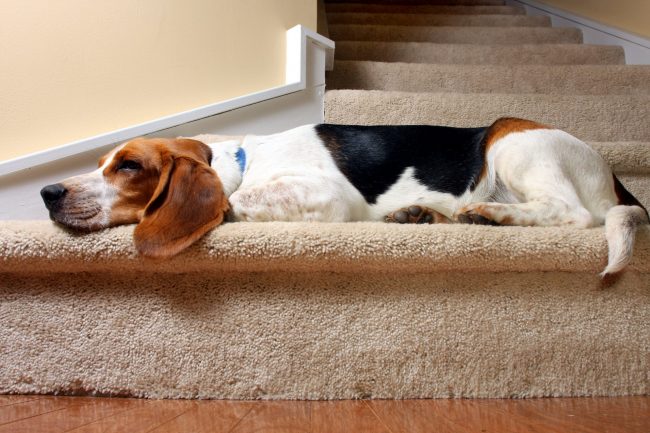Why is my dog limping?
How come my dog won’t climb stairs?
Why won’t my dog jump into the car?
The answer could be your dog is showing signs of canine osteoarthritis (OA). Take the quiz to see your dog's OA risk.
Early signs of OA
Your playful, active dog doesn’t want to slow down, but your dog will give you hints that canine osteoarthritis (OA) is starting to set in. Watch for your dog showing any of these early warning signs:1,2
- Acts more anxious, restless or irritable
- Struggles to get comfortable and frequently changes positions
- Slower to get up or sit down
- Shifts weight from side to side or front to back while standing
- Shows less interest in playing
- Hesitates before doing normal activities like walking, sitting or climbing stairs

OA by the ages
Canine osteoarthritis progresses over time and sneaks up on many dog owners. Signs of the disease are easily dismissed as a dog being tired after play or simply getting older, so pet parents may inadvertently wait to seek help until their dog’s symptoms are serious and debilitating. Ideally, OA will be diagnosed as early as possible in younger dogs so you can begin OA management and treatment to slow down the disease’s advancements as dogs age.

GROWING DOGS
including puppies and young dogs, may show occasional signs of OA that last only a few seconds. Starting veterinary management at this age is ideal to help keep cartilage healthy.

ADULT DOGS
may start to be unable to tolerate exercise and have difficulty performing activities of daily living. OA becomes more difficult to manage at this age because of worn cartilage, but veterinarians can still give dogs of this age some relief from OA.

YOUNG ADULT DOGS
can experience occasional signs that are more frequent and last longer. Veterinary intervention is critical at this age in order to slow down OA so it’s not debilitating later in life.

OLDER DOGS
experiencing OA may show the most advanced signs. If OA isn’t diagnosed and managed earlier in their lives, they may have little or no ability to move when finally diagnosed.

Main causes of OA2
OA can affect any dog – young or old, large or small – but some dogs even more likely to develop OA because of the following:
- While small-breed dogs are susceptible to OA, large- and giant-breed dogs such as these are most commonly affected:
- Golden retrievers
- German shepherds
- Labrador retrievers
- Mastiffs
- Genetics
- Excess bodyweight
- Lack of exercise
- Poor nutrition
- While small-breed dogs are susceptible to OA, large- and giant-breed dogs such as these are most commonly affected:
- Clinician’s Brief, Aug 2013, Canine OA, DA Canapp, DVM, CCRT, CVA, DACVSMR.
- Face validity of a proposed tool for staging canine osteoarthritis: Canine Osteoarthritis Staging Tool (COAST), T. Cachon, O. Frykman, J.F. Innes, B.D.X. Lascelles, M. Okumra, P. Sousa, F. Staffieri, P.V. Steagall, B. Van Ryssen, COAST Developmental Group, The Veterinary Journal, 235 (2018) 1-8.
